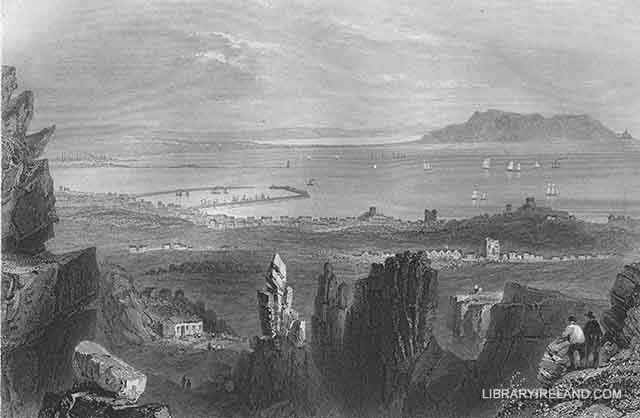Kingstown, County Dublin
Twenty-five years ago the handsome and improving town of Kingstown, situated on the south side of the Bay of Dublin, was a poor village called Dunleary,[42] consisting almost entirely of fishermen's cabins. The construction there of a splendid artificial harbour,[43] where the post-office packets between Liverpool and Dublin deliver and receive the mails, was the first and great step for the prosperity of the town, which has been further advanced by the recent formation of a railroad, which in less than half-an-hour conveys the citizens of Dublin from the middle of a crowded capital to one of the finest sea-bays in Ireland. The view of DUBLIN BAY from the hills adjoining Kingstown, from whence the stones used in the construction of the pier have been quarried, is exceedingly beautiful.
Looking across the bay, which is here about six miles in breadth, we perceive the "big Hill of Howth," with the flat sandy isthmus which unites it to the mainland. The remainder of the shore on the northern side is low, but all along studded with groups of white-walled houses—behind which the land swells into gentle eminences, clothed with wood, and sprinkled with the villas of the gentry. At the extremity of a long straight line of wall, and apparently in the centre of the bay, stands the South Wall Lighthouse, already mentioned; while nearer to the spectator the cheerful-looking streets, houses, and gardens of Kingstown, with the basin of the magnificent harbour, circumscribed by its massive piers, lie distinctly mapped out beneath his feet.
NOTES
[42] It was from this place that George IV. embarked, when quitting Ireland after his memorable visit in 1821; to commemorate this event, a tasteless obelisk was erected on the pier, and the old Irish name of Dunleary changed to Kingstown.
[43] The first stone of this immense work was laid in 1817, by Lord Whitworth, then Lord-Lieutenant of Ireland. The pier extends two thousand eight hundred feet into the sea, and is at the base two hundred feet in breadth; it terminates in a nearly perpendicular face on the side of the harbour, and an inclined plane towards the sea. A quay, fifty feet wide, runs along the summit, protected by a parapet eight feet high on the outside, and a beacon marks the harbour on the extremity of the pier. There is a sufficient depth of water at the lowest springs to admit a frigate of thirty-six guns, or a merchantman of eight hundred tons to take refuge within the harbour, and at two hours' flood there is sufficient water to admit a seventy-four.

